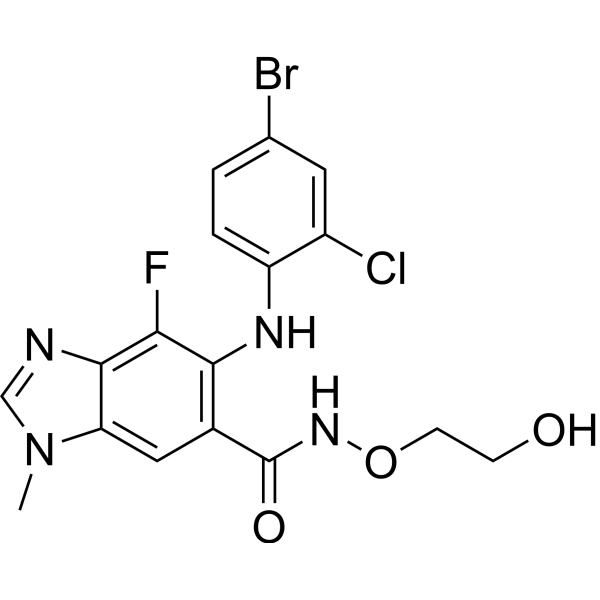Home
Products
Selumetinib (AZD6244)



| Product Name | Selumetinib (AZD6244) |
| Price: | Inquiry |
| Catalog No.: | CN00523 |
| CAS No.: | 606143-52-6 |
| Molecular Formula: | C17H15BrClFN4O3 |
| Molecular Weight: | 457.68 g/mol |
| Purity: | >=98% |
| Type of Compound: | Alkaloids |
| Physical Desc.: | Powder |
| Source: | |
| Solvent: | Chloroform, Dichloromethane, Ethyl Acetate, DMSO, Acetone, etc. |
| SMILES: | OCCONC(=O)c1cc2n(C)cnc2c(c1Nc1ccc(cc1Cl)Br)F |
| Contact us | |
|---|---|
| First Name: | |
| Last Name: | |
| E-mail: | |
| Question: | |
| Description | Selumetinib is a highly potent MEK inhibitor, with an IC50 of 14 nM against MEK1. |
| Target | MEK:12 nM (IC50) MEK1:14 nM (IC50) |
| In Vitro | Selumetinib causes a time- and dose-dependent reduction in DNA synthesis and cell viability in primary, induces growth arrest and apoptosis associated with the inactivation of ERK in primary 2-1318 cells[1]. Selumetinib (1µM) shows anti-proliferative effects through G0/G1 arrest on H-441, H-1437 cells[2]. Selumetinib (ARRY-142886) results in the growth inhibition of several cell lines containing B-Raf and Ras mutations but has no effect on a normal fibroblast cell line[3]. |
| In Vivo | Selumetinib (AZD6244, 50 and 100 mg/kg, p.o.) decreases the growth rate of 4-1318 xenografts in a dose-dependent manner; AZD6244 when given at the dose of 50 mg/kg also significantly suppresses the growth of the 5-1318, 2-1318, 26-1004, and 29-1104 xenografts[1]. Selumetinib (ARRY-142886, 10, 25, 50, or 100 mg/kg, p.o.) is capable of inhibiting both ERK1/2 phosphorylation and growth of HT-29 xenograft tumors in nude mice. Tumor regressions are also seen in a BxPC3 xenograft model[3]. |
| Cell Assay | Primary HCC cells are plated at a density of 2.0×104 per well in growth medium. After 48 h in growth medium, the cell monolayer is rinsed twice with MEM. Cells are treated with various concentrations of Selumetinib (AZD6244, 0, 0.5, 1.0, 2.0, 3.0, and 4.0 μM) for 24 or 48 h. Cell viability is determined by the MTT assay. Cell proliferation is assayed using a bromodeoxyuridine kit as described by the manufacturer. Experiments are repeated at least thrice, and the data are expressed as mean±SE. |
| Animal Admin | To investigate the effects of Selumetinib (AZD6244) on HCC xenografts, AZD6244 is suspended in water at an appropriate concentration. Mice bearing HCC xenografts are p.o. given, twice a day, with either 100 μL of water (n=12) or 50 mg (n=12) or 100 mg (n=12) of AZD6244 per kilogram of body weight for 21 days, starting from day 7 after tumor implantation. Growth of established tumor xenografts is monitored at least twice weekly by Vernier caliper measurement of the length (a) and width (b) of the tumor. Tumor volume is calculated as (a × b2)/2. Animals are sacrificed 3 h after the last dose of ADZ6244, and body and tumor weights are recorded, with the tumors harvested for analysis. |
| Density | 1.7±0.1 g/cm3 |
| Exact Mass | 456.000000 |
| PSA | 88.41000 |
| LogP | 5.55 |
| Storage condition | -20°C |